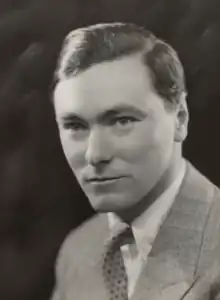Derek Jackson | |
|---|---|
 | |
| Born | Derek Ainslie Jackson 23 June 1906 |
| Died | 20 February 1982 (aged 75) Lausanne, Switzerland |
| Nationality | British |
| Alma mater | Trinity College, Cambridge |
| Known for | Atomic physics |
| Awards | Fellow of the Royal Society[1] |
| Scientific career | |
| Fields | Spectroscopy |
| Institutions | Clarendon Laboratory, Oxford |
| Doctoral advisor | Frederick A. Lindemann |
Derek Ainslie Jackson, OBE, DFC, AFC, FRS[1] (23 June 1906 – 20 February 1982) was a British physicist.[2][3]
Biography
Derek Jackson was born in 1906, the son of Welsh businessman Sir Charles Jackson. Derek Jackson showed early promise in the field of spectroscopy under the guidance of Professor Frederick Lindemann, making the first quantitative determination of a nuclear magnetic spin using atomic spectroscopy to measure the hyperfine structure of caesium. His scientific research at Oxford did not, however, interfere with his other great passion – steeplechase riding – which led him from the foxhunting field to his first ride in the Grand National of 1935. A keen huntsman, he took up the sport again after the war, riding in two more Nationals after the war, the last time when he was 40 years old.
In World War II, Jackson distinguished himself in the RAF, making an important scientific contribution to Britain's air defences and to the bomber offensive. He flew more than a thousand hours as a navigator, many of them in combat in night-fighters, with No. 604 (County of Middlesex) Squadron based at RAF Middle Wallop. He was decorated with the DFC, AFC and OBE. This war record stands in contrast to his stated desire at the war's inception to keep Britain out of fighting Germany. For the rest of his life, Jackson, appointed a Fellow of the Royal Society in 1947, lived as a tax exile in Ireland, France and Switzerland. He continued his spectroscopic work in France at the Centre national de la recherche scientifique, and was made a chevalier de la Légion d'honneur.
A "rampant bisexual",[4][5] Jackson was married six times, and also lived for three years with Angela Culme-Seymour, the half-sister of Janetta Wooley, one of his wives. The others included a daughter of Augustus John, Pamela Mitford (one of the Mitford sisters), a princess and several femme fatales including Barbara Skelton (in whose obituary in the Independent is noted her remark that it was "not for love that (she) married Professor Jackson", he being identified as "the millionaire son of the founder of the News of the World").[6]
Books and publications
- Jackson, D. A. (1928). "Hyperfine structure in the arc spectrum of caesium and nuclear rotation". Proceedings of the Royal Society of London A. 121 (787): 432. Bibcode:1928RSPSA.121..432J. doi:10.1098/rspa.1928.0207.
References
- 1 2 Kuhn, H. G.; Hartley, Christopher (1983). "Derek Ainslie Jackson. 23 June 1906 – 20 February 1982". Biographical Memoirs of Fellows of the Royal Society. 29: 268–296. doi:10.1098/rsbm.1983.0012. JSTOR 769805.
- ↑ Bleaney, B. (2001). "Derek Ainslie Jackson (1906–1982): Some recollections of a great European spectroscopist". Notes and Records of the Royal Society. 55 (2): 285–287. doi:10.1098/rsnr.2001.0144. JSTOR 532101. S2CID 73248246.
- ↑ Jack Morrell (2004). "Jackson, Derek Ainslie (1906–1982)". Oxford Dictionary of National Biography (online ed.). Oxford University Press. doi:10.1093/ref:odnb/31279. (Subscription or UK public library membership required.)
- ↑ Simon Courtauld (2007). As I Was Going to St Ives: A Life of Derek Jackson. Norwich [U.K.]: Michael Russell. ISBN 978-0-85955-311-7.
- ↑ ‘Derek, please, not so fast’, Ferdinand Mount, London Review of Books, 7 February 2008
- ↑ "OBITUARY : Barbara Skelton". Independent.co.uk. 23 October 2011.
- Secondary sources
- Price, Alfred (1967). Instruments of darkness. London: William Kimber. ISBN 9781853676161.
- Diana Mitford (1985). Loved Ones. Sidgwick & Jackson. ISBN 9780283991554.
- Alexander, Diana (2012). The Other Mitford: Pamela's Story. Stroud.
{{cite book}}: CS1 maint: location missing publisher (link)